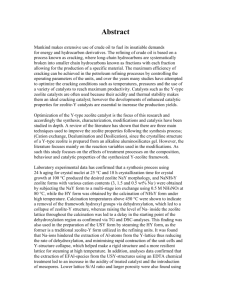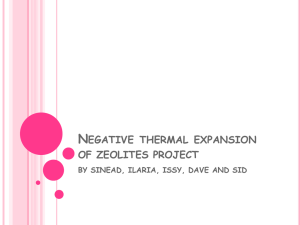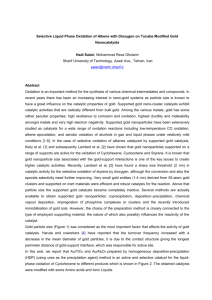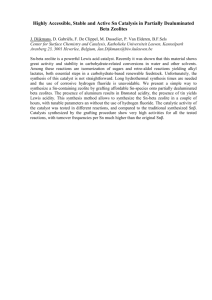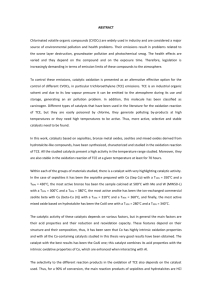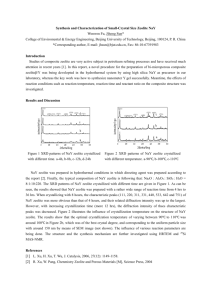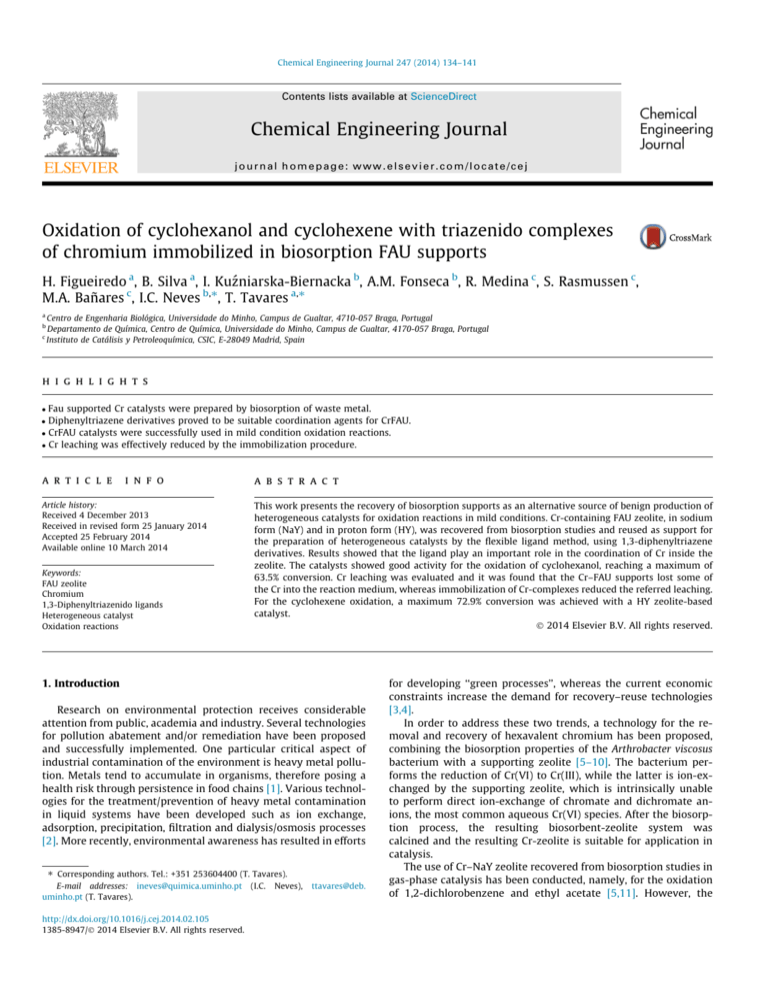
Chemical Engineering Journal 247 (2014) 134–141
Contents lists available at ScienceDirect
Chemical Engineering Journal
journal homepage: www.elsevier.com/locate/cej
Oxidation of cyclohexanol and cyclohexene with triazenido complexes
of chromium immobilized in biosorption FAU supports
H. Figueiredo a, B. Silva a, I. Kuźniarska-Biernacka b, A.M. Fonseca b, R. Medina c, S. Rasmussen c,
M.A. Bañares c, I.C. Neves b,⇑, T. Tavares a,⇑
a
b
c
Centro de Engenharia Biológica, Universidade do Minho, Campus de Gualtar, 4710-057 Braga, Portugal
Departamento de Química, Centro de Química, Universidade do Minho, Campus de Gualtar, 4170-057 Braga, Portugal
Instituto de Catálisis y Petroleoquímica, CSIC, E-28049 Madrid, Spain
h i g h l i g h t s
Fau supported Cr catalysts were prepared by biosorption of waste metal.
Diphenyltriazene derivatives proved to be suitable coordination agents for CrFAU.
CrFAU catalysts were successfully used in mild condition oxidation reactions.
Cr leaching was effectively reduced by the immobilization procedure.
a r t i c l e
i n f o
Article history:
Received 4 December 2013
Received in revised form 25 January 2014
Accepted 25 February 2014
Available online 10 March 2014
Keywords:
FAU zeolite
Chromium
1,3-Diphenyltriazenido ligands
Heterogeneous catalyst
Oxidation reactions
a b s t r a c t
This work presents the recovery of biosorption supports as an alternative source of benign production of
heterogeneous catalysts for oxidation reactions in mild conditions. Cr-containing FAU zeolite, in sodium
form (NaY) and in proton form (HY), was recovered from biosorption studies and reused as support for
the preparation of heterogeneous catalysts by the flexible ligand method, using 1,3-diphenyltriazene
derivatives. Results showed that the ligand play an important role in the coordination of Cr inside the
zeolite. The catalysts showed good activity for the oxidation of cyclohexanol, reaching a maximum of
63.5% conversion. Cr leaching was evaluated and it was found that the Cr–FAU supports lost some of
the Cr into the reaction medium, whereas immobilization of Cr-complexes reduced the referred leaching.
For the cyclohexene oxidation, a maximum 72.9% conversion was achieved with a HY zeolite-based
catalyst.
Ó 2014 Elsevier B.V. All rights reserved.
1. Introduction
Research on environmental protection receives considerable
attention from public, academia and industry. Several technologies
for pollution abatement and/or remediation have been proposed
and successfully implemented. One particular critical aspect of
industrial contamination of the environment is heavy metal pollution. Metals tend to accumulate in organisms, therefore posing a
health risk through persistence in food chains [1]. Various technologies for the treatment/prevention of heavy metal contamination
in liquid systems have been developed such as ion exchange,
adsorption, precipitation, filtration and dialysis/osmosis processes
[2]. More recently, environmental awareness has resulted in efforts
⇑ Corresponding authors. Tel.: +351 253604400 (T. Tavares).
E-mail addresses: ineves@quimica.uminho.pt
uminho.pt (T. Tavares).
http://dx.doi.org/10.1016/j.cej.2014.02.105
1385-8947/Ó 2014 Elsevier B.V. All rights reserved.
(I.C.
Neves),
ttavares@deb.
for developing ‘‘green processes’’, whereas the current economic
constraints increase the demand for recovery–reuse technologies
[3,4].
In order to address these two trends, a technology for the removal and recovery of hexavalent chromium has been proposed,
combining the biosorption properties of the Arthrobacter viscosus
bacterium with a supporting zeolite [5–10]. The bacterium performs the reduction of Cr(VI) to Cr(III), while the latter is ion-exchanged by the supporting zeolite, which is intrinsically unable
to perform direct ion-exchange of chromate and dichromate anions, the most common aqueous Cr(VI) species. After the biosorption process, the resulting biosorbent-zeolite system was
calcined and the resulting Cr-zeolite is suitable for application in
catalysis.
The use of Cr–NaY zeolite recovered from biosorption studies in
gas-phase catalysis has been conducted, namely, for the oxidation
of 1,2-dichlorobenzene and ethyl acetate [5,11]. However, the
H. Figueiredo et al. / Chemical Engineering Journal 247 (2014) 134–141
utilization of Cr–NaY matrices in liquid-phase oxidation reactions
requires previous immobilization of the Cr species in the support,
in order to overcome the possible Cr leaching [12–14]. Since leaching of active metal centres into the solution is undesirable, various
strategies for immobilization of catalytically active metal centres
in inorganic matrices have been proposed. Some of the methods
to obtain the heterogeneous catalysts include coordination of the
metal with ligands by anchoring it to the support or by in situ synthesis of the complex inside the host, the so called ship in bottle
synthesis [15–18].
Encapsulation of metal species in zeolites is a method that has
been studied for a quite long time [19] and is known to be efficient
for the immobilization of transition metal complexes. Faujasite
(FAU) zeolites possess well-defined supercages interlinked with
three-dimensional channels with wide pore openings (12 oxygen
atoms), which makes these supports ideal hosts for the encapsulation of metal complexes via the flexible ligand method. This heterogeneous class of catalysts has found application on several fields
in catalysis such as preparation of fine chemicals [15], photocatalysis and electrocatalysis [17].
Oxidation of alcohols to the corresponding ketones and aldehydes is a key reaction in organic synthesis [20–22], since the
selective formation of carbonyl functional groups in hydrocarbons
makes them useful intermediaries for pharmaceuticals and cosmetic products [23]. Cr-containing catalysts have found application on the oxidation of several organic substrates, including
cyclohexene and cyclohexanol [24–26]. The latest is of particular
interest, as the liquid-phase oxidation of secondary alcohols often
employs homogeneous Cr(VI) catalysts, which requires previous
preparation of catalyst and demands for an efficient disposal of
the metal after reaction, given its toxicity [22].
This work reports the preparation of heterogeneous chromium
catalysts from Cr-biosorption FAU supports and the application
of these catalysts to liquid-phase oxidation reactions in mild conditions. For the effect, 1,3-diphenyltriazene derivatives were used
as ligands for the immobilization of the Cr species inside the
framework of FAU zeolite. The oxidation of cyclohexanol and cyclohexene were chosen as model reactions for the validation of the
catalytic activity.
2. Experimental section
2.1. Materials and procedures
A. viscosus was obtained from the Spanish Type Culture Collection of University of Valência. Potassium dichromate aqueous solutions were prepared by diluting K2Cr2O7 (Panreac) in distilled
water, in concentrations up to 100.0 mgCr/L. The FAU supports,
NaY and HY zeolites, were supplied by Zeolyst International (commercial names CBV100 and CBV400, respectively) in powder form.
Bulk Si/Al ratios are 2.83 and 2.80 for NaY and HY, respectively.
Both zeolites were calcined at 500 °C during 8 h under a dry air
stream prior to use. All glassware used for experimental purposes
was washed in 10% nitric acid to remove any possible interference
by other metals. Atomic absorption spectrometric standards were
prepared from 1000 mg L1 solution. 1,3-diphenyltriazene derivatives (1a, 1b and 1c) were prepared using a previously described
procedure in literature [27,28]. All the other chemicals and solvents used for the catalysts preparation and for the catalytic reactions were reagent grade and purchased from Aldrich.
2.2. Immobilization of Cr complexes in FAU supports
Immobilization of Cr(III) complexes in the Cr–FAU supports was
based in a previously established procedure [29]. Cr–FAU supports
135
were prepared by different biosorption treatments: the sample
CrNaY was recovered from a single-batch process, whereas
CrNaYSBR and CrHYSBR were obtained from processes involving
sequential batch reactors (hence the suffix SBR) and in all cases
an initial 100 mgCr/L dichromate solution was used [6]. All recovered samples were previously calcined at 500 °C under dry air flow
for 8 h. For the immobilization of 1,3-diphenyltriazenido chromium complex in the Cr–FAU supports the coordination was obtained with ligand 1,3-diphenyltriazene (1a). Two more ligands,
1,3-bis(p-methylphenyl)triazene (1b) and 1,3-bis(p-nitrophenyl)
triazene (1c) were used for coordination with Cr in CrNaY support
in order to compare the efficiency of Cr immobilization.
The catalysts were prepared via a flexible ligand method consisting of three steps: in situ complex synthesis, liquid–solid
extraction and stabilization. For the first step, 0.28 mmol of the selected ligand in 100 mL of ethanol solution and 1.0 g of Cr–FAU
host (previously dried at 150 °C under vacuum) were refluxed for
24 h with moderate stirring. The solid is recovered by filtration
and dried overnight at 60 °C. Liquid–solid Soxhlet extraction was
conducted with 50 mL of dichloromethane for 5 h. Finally, the stabilization of the catalyst was performed under moderated stirring
at room temperature for 24 h with 50 mL of 0.01 M NaNO3 solution. The solid is recovered from this solution by filtration, followed by overnight drying at 60 °C.
2.3. Catalytic oxidation of cyclohexene and cyclohexanol
The oxidation reaction of cyclohexene is conducted in a 50 mL
three-way flask equipped with a condenser and thermometer.
The reaction mixture is as follows: 5.8 mL decane (solvent),
0.2 mL cyclohexene (substrate), 0.4 mL toluene (internal standard
for GC analysis) and 2.0 mL of tert-butyl hydroperoxide (TBHP)
5.5–6.0 M in decane (oxygen source). For the catalyzed reactions,
an amount of 50.0 mg of previously dried catalyst is transferred
into the reaction mixture before the addition of TBHP. The reactor
is placed in an oil bath at the desired reaction temperature (controlled by a thermostat at 50 °C) and the mixture is moderately
stirred for 23 h. The evolution of cyclohexene and oxidation products is followed by GC analysis.
The oxidation reaction of cyclohexanol is conducted in similar
conditions as for the oxidation of cyclohexene, with the exception
of the composition of the reaction mixture which is as follows:
5.0 mL diethylketone (solvent), 0.3 mL cyclohexanol (2.9 mmol of
substrate), 0.4 mL chlorobenzene (standard for GC analysis) and
2.0 mL of 5.5–6.0 M TBHP in decane. The reaction temperature is
set to 60 °C and the mixture is moderately stirred for 23 h. All
blank experiments, without catalyst and using NaY and HY zeolites
as catalyst, were performed under the same conditions.
2.4. Characterization procedures
Scanning electron microscopy (SEM) surface analysis was performed on a Nova NanoSEM 200 microscope under high vacuum,
coupled to EDAX – Pegasus X4M energy-dispersive spectrometer
(EDS), with beam energy of 15.00 kV. X-ray photoelectronic spectra
(XPS) of the supports/catalysts were obtained with a VG Escalab
200 R XPS spectrometer fitted with an Mg Ka X-ray source at
120 W. Carbon was used as internal standard for all samples, with
correction of the corresponding binding energy of C to 284.6 eV.
Fourier-Transform Infrared spectra (FTIR) of solid samples were recorded within the 4000–500 cm1 range with a Bomem MB104
spectrometer, using KBr pellets (sample/KBr mass ratio was
1:100). Raman spectra of solid samples were recorded on a
Perkin–Elmer Raman Station 400F fitted with a 785 nm
wavelength laser with a maximum power at sample of 100 mW.
Accumulations, total accumulation time and power at sample
136
H. Figueiredo et al. / Chemical Engineering Journal 247 (2014) 134–141
parameters were adjusted in order to minimize the effect of background fluorescence on each sample. EPR spectra were collected
with a Bruker EMX EPR spectrometer at 77 K using a finger dewar
inserted into a Bruker standard ER4102ST cavity. The microwave
frequency was around 9.42 GHz. Before acquisition of EPR spectra,
the samples were dried overnight at 120 °C. Chemical analysis of C,
N and H was conducted on a Leco CHNS-932 analyzer. The determination of Cr content of each solid support was carried out by
inductively coupled plasma atomic emission spectrometry (ICPAES) using a Philips ICP PU 7000 Spectrometer. Thermogravimetric
analysis (TGA) was conducted on a Shimadzu TGA-50 instrument.
Samples were placed in aluminium crucibles and were characterized between 25 and 580 °C under a constant heating rate of
6 °C/min and 50 mL/min of N2 flow. BET areas of the supports/catalysts were determined from N2 adsorption isotherms performed
on an automatic Micromeritics ASAP-2000 apparatus. Samples
were previously outgassed at 140 °C for 2 h. Acid digestion of liquid samples from catalytic reactions were performed in a microwave (0.5 mL of sample for 10.0 mL of HNO3) and analysed for Cr in
a Varian SpectrAA-250 atomic absorbance spectrometer. Liquid
samples from catalytic reactions were analysed by gas chromatography on a SRI Instruments 8610C gas chromatograph, fitted with a
CP-Sil 8CB capillary column and FID detector.
3. Results and discussion
3.1. Preparation and characterization of the heterogeneous Cr–FAU
catalysts
In the present study, Cr–FAU structures are used as hosts for the
preparation of catalysts and their application in liquid-phase oxidation reactions is reported. The Cr–FAU zeolites were recovered
from different batch assays supporting Cr(VI) biosorption studies.
In short, the A. viscosus bacteria, supported on FAU zeolites, bioreduces Cr(VI) species to Cr(III) ions and these cations in aqueous
medium are then easily ion-exchanged by the zeolitic support.
All Cr–FAU zeolites were recovered from an initial 100 mgCr/L
dichromate solution, with uptake values of 11.7, 8.3 and 6.7 mgCr/
gzeolite for CrNaY, CrHYSBR and CrNaYSBR, respectively. This difference in uptake performance results in different Cr loadings of the
supports. Full details on the biosorption-recovered supports were
described elsewhere [6].
The recovered structures were calcined in order to remove the
supported biomass and other organic matter, resulting in Cr–FAU
materials. These starting materials for preparation of the different
catalysts were named CrHYSBR and CrNaYSBR, for those recovered
from the sequential batch process (SBR), whereas CrNaY was
recovered from a single-batch process [6].
The in situ synthesis of Cr(III) complexes in FAU zeolite supercages was performed by the flexible ligand method in the liquid
phase using an excess of the 1,3-diphenyltriazene derivatives,
named 1a, 1b and 1c (Fig. 1). Three triazenido derivatives ligands
with different donor and acceptor substituents in para-phenyl
group were used: 1,3-diphenyltriazene (1a), 1,3-bis(p-methylphenyl)triazene (1b) and 1,3-bis(p-nitrophenyl)triazene (1c). All ligands could be chelated by the 1,3-nitrogen atoms [30].
The coordination of chromium by these ligands is strongly affected by the substituents in para-aryl position. The nitro group
in para position of the aromatic ring decreases the coordination
of triazenido as a result of its electrowithdrawing ability. However,
methyl groups in para position increase the electronic density in
the triazenido group, resulting in enhanced coordination. The environment medium for the coordination has also an important influence on the final complexes because it is necessary to ensure that
Fig. 1. Structure of 1,3-diphenyltriazene derivatives.
the deprotonation of the acidic hydrogen in triazene group occurs
[31].
Several different techniques were used to evaluate the immobilization of 1,3-diphenyltriazenido chromium complexes in the
supercages of the host zeolites obtained by different processes in
the Cr catalysts.
SEM analysis is important to confirm that the calcination step
after the biosorption process removes the biofilm from the zeolite
[29,32]. Fig. 2 presents the field emission scanning electron micrograph (Fig. 2a) and the surface EDS spectrum (Fig. 2b) of CrHYSBR as
a representative example.
The typical faujasite zeolite morphology was preserved and has
well defined particles with average sizes between 0.2 and 0.5 lm
(Fig. 2a). No changes in the zeolite morphology or structure upon
complex encapsulation were observed. Energy-dispersive X-ray
analysis shows the presence of Cr in the matrix by the respective
Ka line at 5.40 keV [33] and a residual amount of phosphor was detected at 2.03 keV [34], which is most likely a scattered biomass
residue from calcination (Fig. 2b).
The XPS analysis provided valuable information about the presence of chromium on the surface layer of supports, as well as about
the oxidation state of the metal. All catalysts revealed the presence
of oxygen, sodium, silicon, nitrogen and aluminium in their XPS
resolution spectra. The presence of chromium was detected in region of Cr 2p. The spectrum showed two bands at binding energies
of 577.4 eV and 586.6 eV. The first corresponds to a Cr 2p3/2 and the
second to a Cr 2p1/2. Fig. 3 presents the peak fitting of the signal on
the Cr 2p XPS spectrum of CrNaY, as an example.
After deconvolution in the Cr 2p3/2 region, the peak at 577.4 eV
is attributed to Cr(III), while signals at 581.3 and 579.5 eV may be
due to the presence of Cr(VI) [26,35]. The presence of Cr(III) is due
to the reduction of Cr(VI) to Cr(III) during the biotreatment process.
The biomass is responsible for this reduction, while the zeolite performed the entrapment of Cr(III) by ion-exchange [6,9]. Similar results were observed by Park et al. [36], who concluded that the
biomass by itself would only retain Cr(III) ions. The presence of
Cr(VI) in CrNaY could be due to the calcination treatment
re-oxidating a fraction of the exchanged Cr(III) species to Cr(VI).
This fact was reported by Weckhuysen et al., who stated that Cr(III)
ion-exchanged Y zeolites would form chromate species upon
calcination in an oxygen-rich atmosphere [37]. Since the recovered
biosorption supports were calcined under dry air flow, it is likely
that a partial oxidation occurred and the supports contained both
Cr(VI) and Cr(III) species.
Additional structural information was obtained by Raman spectroscopy that can identify chromium species present in these catalysts. Fig. 4 presents the Raman spectra of CrNaY support and
the homologous catalysts prepared with the three different ligands. Although the spectra are dominated by the intrinsic background fluorescence of calcined zeolitic samples [38], it is
possible to identify peaks at 1360 and 942 cm1 in [CrL1a]NaY
and [CrL1b]NaY. The spectrum of [CrL1c]NaY is similar to the one
137
H. Figueiredo et al. / Chemical Engineering Journal 247 (2014) 134–141
a
b
O
Counts
Si
Al
P
C
Cr
0
1
2
3
4
5
6
keV
Fig. 2. (a) Scanning electron microscopy (10.000) and (b) energy dispersive spectrum of CrHYSBR.
577.4
581.3
586.6
592
590
588
579.5
586
584
582
580
578
576
574
Binding Energy (eV)
Fig. 3. Peak fitting of the Cr 2p region on the XPS spectrum of CrNaY.
942
500
1360
CrNaY
[CrL1a]NaY
[CrL1b]NaY
[CrL1c]NaY
3000
2000
1000
Raman Shift (cm-1)
and HY are characterized by a very intense broad band at ca.
3460 cm1, with a poor resolved shoulder at ca. 3600 cm1 attributed to the hydroxyl groups in the supercages and in the sodalite
cages, respectively [41,42]. In the low energy region, the spectrum
showed a band at 1640 cm1 characteristic of the d(H2O) mode of
absorbed water [43]. The band at ca. 1020 cm1 is usually attributed to the asymmetric stretching of Al–O–Si chain of zeolite.
The symmetric stretching and bending frequency bands of Al–O–
Si framework of zeolite appear at ca. 727 and 513 cm1, respectively [44]. As an example, the spectra for CrNaY and [CrL1a]NaY
provide evidence that the zeolite framework is preserved throughout calcination and immobilization of the 1,3-diphenyltriazenido
chromium complex (Fig. 5). The spectrum of [CrL1a]NaY shows
the bands at 1492 and 1593 cm1, attributed to the m(N N N) of
the triazene group, which proves that this ligand was successfully
coordinated into the framework zeolite.
The EPR spectra of the triazenido chromium complexes on NaY
and CrNaY are shown in Fig. 6, while Table 1 presents characteristic
EPR data. The principal g-value of the samples was calculated from
their EPR spectra by using the standard procedure [26,45].
CrNaY exhibit a fairly sharp, slightly anisotropic signal at a g\
value around 1.97 (denoted g1 in Table 1), which probably represents Cr species in square pyramidal conformation, since the gk line
appears to be around 1.957 [26]. The immobilized samples contain
similar bands and in addition to that a signal at g = 2.0 (denoted g2
in Table 1). However, it should be noted that the spectral features
of the [CrL1c]NaY sample are quite similar to those of the parent
CrNaY. The EPR lines for FAU supports and for CrL1a and CrL1b in
FAU supports appear as a combination of the mentioned signals
at g = 1.97 and 2.0. Especially in the case of the [CrL1a]HYSBR sample
an anisotropic broadening of the g = 1.97 signal is observed, which
could suggest some change in the coordination environment of Cr
of CrNaY. The first signal corresponds to the D-band of carbon compounds [39], while the second peak resembles the most intense
Raman band of alkali chromates species [26]. The presence of these
species could be related to the calcination conditions that favour
the oxidation of Cr(III) to Cr(VI). Cr(III)-related Raman bands are
expected at 550 cm1 but are not visible in the spectra, mainly
due overlapping with the intense 500 cm1 Raman band that is
typical for FAU zeolites [40].
The immobilization of chromium complexes in the biosorption
FAU supports was demonstrated by FTIR and EPR analysis. All FTIR
spectra of biosorption FAU supports and of the catalysts are dominated by the strong bands attributed to the zeolite structure. No
shift or broadening of the zeolite vibration bands is observed upon
incorporation of the chromium complex. The FTIR spectra of NaY
Transmittance
Fig. 4. Raman spectra of CrNaY and of the respective catalysts.
[CrL1a]NaY
CrNaY
4000
3500
3000
2500
2000
1500
1000
-1
Wavenumber (cm )
Fig. 5. Infrared spectra of CrNaY and [CrL1a]NaY.
500
138
H. Figueiredo et al. / Chemical Engineering Journal 247 (2014) 134–141
CrNaY
[CrL1a]NaY
[CrL1b]NaY
[CrL1c]NaY
[CrL1a]NaYSBR
[CrL1a]HYSBR
3200
3400
3600
Magnetic field (G)
Fig. 6. EPR spectra for CrNaY and the respective catalysts. Data collected at 77 K.
Table 1
EPR data for the different samples.
EPR signals
a
Sample
g1
Band width
(ppa) (G)
CrNaY
[CrL1a]NaY
[CrL1b]NaY
[CrL1c]NaY
[CrL1a]NaYSBR
[CrL1a]HYSBR
1.971
1.973
1.978
1.972
1.976
1.975
25
28
35
32
32
39
g2
Band width
(pp) (G)
2.002
2.003
22
20
2.001
2.002
19
15
pp: Peak to peak band width on derivative EPR spectra.
due to the complexation into FAU supercages [26]. Since the samples were only dried at 120 °C, it is reasonable to assume that some
intra-zeolitic water might still be present, which coordinates to
Cr(III) in the in situ synthesis of the complex.
Combined chemical, thermogravimetric and textural analyses
were performed to compare the immobilization of chromium complexes within the different biosorption supports. The combined
data are detailed in Table 2.
The immobilization of the Cr complexes in biosorption supports
was confirmed by the analytical data of carbon, nitrogen and metal. The highest Cr/N ratio observed for CrNaYSBR suggests the presence of a fraction of chromium not coordinated with the ligand. It
was found that a part of this chromium could be located in framework sites that are inaccessible for the ligands [27,45]. The lower
nitrogen amount in the [CrL1c]NaY catalyst shows that the complex
with 1,3-bis(p-nitrophenyl)triazene (1c) ligand was not achieved,
in agreement with Raman, FTIR and EPR analyses. These results
are due to the decrease of the donor groups strength of the triazenido ligand by the NO2 group in para position in acidic medium [31].
It should be referred that the biosorption assays were performed at
pH 4.00 in order to increase the reduction of the Cr(VI) species.
The low amount of Cr complexes is related to the presence of the
different Cr species in the biosorption FAU supports. Cr(VI) species
detected by XPS and Raman are not coordinated with the triazenido
ligands which means that only a small fraction of chromium takes
part in the synthesis of the complex and this fraction is trivalent.
Thermogravimetric analysis also confirmed that immobilization
of Cr complexes was achieved. TG and DTG curves of the biosorption FAU supports and of the catalysts show a weight loss at 110 °C
which is attributed to the loss of water molecules present in the
framework of the zeolite. After the synthesis, the catalysts based
in 1,3-diphenyltriazene (1a) and 1,3-bis(p-methylphenyl)triazene
(1b) ligands presented a secondary weight loss, taking place at a
higher temperature, around 410 °C, which is attributed to the
decomposition of the organic matter from the complexes. Fig. 7
presents the TGA–DTG data for [CrL1a]NaY, as an example.
The different weight losses observed for the catalysts confirm
that the 1,3-bis(p-nitrophenyl)triazene (1c) ligand is not coordinated with chromium. In the case of the chromium complex
formed in CrNaYSBR the TGA results show that the lower amount
of the complex is related to the lower amount of entrapped
chromium.
The extent of the secondary weight loss varied with the different combinations of support and 1,3-diphenyltriazene (1a) ligand.
This ligand was able to form up to 2.5% (w/w) mass of chromium
complex within CrNaY and CrHYSBR. Despite having different chromium loadings, the formation of complex with 1a ligand was comparable between these two supports.
For all catalysts, the total surface areas were calculated by the
BET equation (SBET) and the data show a reduction in area after
the complexation, when compared to the respective parent supports, which is a further indication of successful immobilization
[46,47]. The decreasing of the BET area is specially significant for
the catalysts obtained from CrNaY and CrHYSBR.
3.2. Oxidation of cyclohexanol
The catalytic behaviour of the different chromium complexes in
biosorption FAU supports was tested for the oxidation of cyclohexanol using TBHP as an oxygen source. Blank experiments without
catalyst and in the presence of parent NaY or HY were performed
under identical experimental conditions. Cyclohexanone was
found to be the only significant product of the reaction studied
[48]. Table 3 presents the results achieved by different catalysts
after 23 h.
From the results presented in Table 3, it is seen that the presence of chromium ions on the support greatly increases cyclohexanol conversion, while parent NaY and HY zeolites proved to be
Table 2
Characterization data of the materials.
Support
Ligand
BET surface area (m2 g1)
Cb
Nb
Cr/N
Complex mass (%, w/w)
1a
1b
1c
0.75
0.71
0.71
0.72
0
0.75
1.23
0.10
0
0.19
0.20
0.02
3.74
3.55
2.5
2.1
0.2
593
196
317
563
1a
0.46
0.47
0
0.32
0
0.05
9.40
0.8
590
540
1a
0.59
0.55
0
1.04
0
0.29
1.89
2.5
496
201
CrNaYSBR
CrHYSBR
a
TGA analysis
Cra
CrNaY
b
Elemental analysis (%, w/w)
Cr loading on FAU supports determined by ICP-AES analysis.
Carbon and nitrogen from Cr complexes obtained by elemental analysis.
139
H. Figueiredo et al. / Chemical Engineering Journal 247 (2014) 134–141
100
CrNaY
[CrL1a]NaY
DTG
Sample Mass (% w/w)
110
90
80
0
100
200
300
400
500
almost no complexation took place in the latter material. Since
chromium leaching from Cr-containing catalysts is acknowledged,
even when TBHP oxidant is used [13], liquid samples of each reaction were digested and analysed for total chromium content. The
result of this determination is presented in Table 3. It may be seen
that chromium was detected on the reaction medium of all
modified materials, proving that there is a contribution from
homogeneous catalysis to the overall conversion. However, the
immobilized catalysts prepared from biosorption FAU supports
presented a smaller amount of leached chromium when compared
to the correspondent untreated biosorption supports. CrHYSBR is
the least leaching-prone material, while leaching from its complex
immobilized counterpart, [CrL1a]HYSBR is negligible. Catalysts
based on NaY show higher leaching of active species.
600
Temperature (ºC)
3.3. Oxidation of cyclohexene
Fig. 7. TG and DTG curves of CrNaY and [CrL1a]NaY.
Table 3
Results for the catalytic oxidation of cyclohexanol.
TONa
Cr Leaching
(lg)
±1.2
±3.0
±1.7
±2.8
246
243
201
266
47.8
28.5
17.5
40.9
56.8
49.1
±4.5
±4.6
373
315
29.6
18.3
48.0
42.9
±1.1
±2.9
245
235
20.1
4.4
Catalyst
Cyclohexanol
conversion (%)
Analytical
error (%)
(blank
reaction)
NaY zeolite
HY zeolite
18.6
±3.5
15.8
14.2
±5.3
±1.4
CrNaY
[CrL1a]NaY
[CrL1b]NaY
[CrL1c]NaY
61.2
57.3
54.1
63.5
CrNaYSBR
[CrL1a]NaYSBR
CrHYSBR
[CrL1a]HYSBR
a
Turnover number (TON) was determined from the converted cyclohexanol
moles over the initial molarity of Cr in the respective catalyst.
inefficient for this reaction, as the substrate conversion is very
close to blank. TON values are higher for the catalysts based on
NaY prepared by SBR method. This might be due to the presence
of chromium species in zeolite sites that are accessible to the reactants [49].
The samples with immobilised chromium complex present a
slight decrease in cyclohexanol conversion when compared to
biosorption FAU supports except [CrL1c]NaY. The CrNaY and
[CrL1c]NaY catalysts led to very close cyclohexanol conversion values. This result supports the characterization data that indicated
The catalysts were also tested for the oxidation of cyclohexene.
The reaction mechanism in the presence of Cr-containing catalysts
has already been proposed [29] and the main products obtained
from this reaction are 2-cyclohexene-1-ol (CyOL), 2-cyclohexene1-one (CyONE), and 1-tert-butylperoxy-2-cyclohexene (CyOX),
proving that only allylic oxidation takes place. The latter was found
to behave as an intermediary towards the formation of CyONE and
CyOL, which has been reported by other authors [46].
The overall conversion of cyclohexene, product selectivity and
TON are presented in Table 4.
It was found that the presence of chromium in the biosorption
FAU supports greatly increases the conversion of cyclohexene. The
products distribution depends on catalyst used. The NaY and HY
zeolites were just able to originate the intermediary CyOX. CyONE
was the main product when chromium modified catalysts were
used and for these catalysts a small decrease in cyclohexene conversion was observed, when compared to the parent biosorption
supports.
The highest cyclohexene conversion was achieved for the
CrHYSBR catalyst. The comparison of substrate conversion reached
in blank reaction and in the presence of NaY and HY, shows that
HY zeolite is slightly active in this reaction, whereas NaY is inactive. The substrate conversion values with allowance for the background reaction (HY) are 61.1% and 59.8% for CrHYSBR and for
[CrL1a]HYSBR, respectively, and they are of the same order of magnitude as for CrNaYSBR based counterparts. This fact explains the
higher conversion of CrHY based catalysts and they can be considered as bifunctional catalysts for this particular reaction.
[CrL1c]NaY catalyst leads to lower substrate conversion than
CrNaY. This might be due to the retardation effect on TBHP decomposition (free radical formation) by the presence of small amounts
of free 1c ligand in [CrL1c]NaY [50].
Table 4
Conversion, product selectivity and turn-over numbers for the oxidation of cyclohexene.
Catalyst
Cyclohexene conversion (%)
Analytical error (%)
Product selectivity (%)
CyOLl
(blank reaction)
NaY
HY
CrNaY
[CrL1a]NaY
[CrL1b]NaY
[CrL1c]NaY
CrNaYSBR
[CrL1a]NaYSBR
CrHYSBR
[CrL1a]HYSBR
16.9
11.1
28.7
69.0
56.0
55.1
60.4
61.2
60.8
72.9
71.6
±5.9
±2.2
±4.8
±1.8
±1.5
±2.5
±3.1
±1.0
±1.1
±1.4
±1.3
21.6
12.2
15.1
15.4
16.7
14.4
25.0
22.8
TON
CyONE
CyOX
67.8
69.4
74.0
71.6
68.9
63.0
65.0
66.8
100.0
100.0
100.0
10.7
18.5
10.8
13.0
14.3
22.7
10.0
10.3
190
164
140
173
278
267
255
269
140
H. Figueiredo et al. / Chemical Engineering Journal 247 (2014) 134–141
The lower substrate conversion for chromium complex modified catalysts is observed as it was for cyclohexanol oxidation. As
it was mentioned above, the chromium entrapped in the zeolite
by the biosorption process is in the trivalent form before calcination. The experimental evidences clearly demonstrated that part
of the trivalent chromium impregnated onto zeolite surface is oxidised to hexavalent chromium during the calcination process, as it
was seen for chromium(III) acetate impregnated onto silica gel
[51]. During the calcination process, the bulky CrO3 can be gradually grafted onto zeolite surface through esterification reaction
with surface hydroxyl groups [51,52]. It is still very difficult to distinguish between anchored Cr(VI) species from bulky CrO3 by XPS.
Nevertheless, according to the results from Raman, TGA and XPS
the existence of mixed oxidation states of chromium species,
namely Cr(III) and Cr(VI) in the studied catalysts may be postulated. It is known from literature that Cr(III) complexes are active
in oxidation of cyclohexene [53], as well as free CrO3 and anchored
Cr(VI) species [54]. Thus, the triazenido complexes formed in zeolite matrix are also catalytically active but probably restrain the access of the substrate and oxidant to other catalytic active sites. The
lowering of substrate conversion (cyclohexanol and cyclohexene)
can be explained by the´ blockinǵ effect of the complex formed.
4. Conclusions
Chromium complexes have been successfully prepared within
biosorption FAU supports, using 1,3-diphenyltriazene derivatives.
The electrowithdrawing properties of substituents of these ligands
play an essential role in the coordination process. The supports,
based in a low-cost system combining the biosorption properties
of a microorganism with the ion exchange properties of a zeolite,
were able to remove hexavalent chromium from contaminated
water and were used for this immobilization. After the biosorption
processes, FAU zeolites loaded with chromium were used as competitive catalysts in the oxidation of cyclohexanol and cyclohexene. CrNaY-derived catalysts promoted higher cyclohexanol
conversion, whereas CrHY-derived catalysts presented bifunctionality for the oxidation of cyclohexene, ultimately yielding a higher
conversion. The immobilization of chromium complexes proved to
be efficient on limiting the metal leaching proneness observed on
the untreated biosorption supports.
Acknowledgments
H. Figueiredo and B. Silva are thankful to the ‘‘FCT – Fundação
para a Ciência e Tecnologia’’ for their respective research grants.
IKB thanks FCT for the contract under the program Ciência 2007.
This work was partially funded by the Centre of Biological
Engineering and the Centre of Chemistry (University of Minho,
Portugal) through FCT strategic projects PEst-OE/EQB/LA0023/
2013 and PEst-C/QUI/UI0686/2011 (nF-COMP-01-0124-FEDER022716), the Project ‘‘BioEnv - Biotechnology and Bioengineering
for a sustainable world’’, REF. NORTE-07-0124-FEDER-000048,
co-funded by the Programa Operacional Regional do Norte (ON.2
– O Novo Norte), QREN and FEDER, and by the Spanish Ministry
of Science and Innovation (CTQ2008-04261/PPQ).
References
[1] M. Gavrilescu, Removal of Heavy Metals from the Environment by Biosorption,
Eng. Life Sci. 4 (2004) 219–232.
[2] E. Erdem, N. Karapinar, R. Donat, The removal of heavy metal cations by
natural zeolites, J. Colloid Interface Sci. 280 (2004) 309–314.
[3] H. Eccles, Treatment of metal-contaminated wastes: why select a biological
process?, Trends Biotechnol 17 (1999) 462–465.
[4] A. Agrawal, V. Kumar, B.D. Pandey, Remediation options for the treatment of
electroplating and leather tanning effluent containing chromium – a review,
Miner. Process. Extr. Metall. Rev. 27 (2006) 99–130.
[5] H. Figueiredo, I.C. Neves, C. Quintelas, T. Tavares, M. Taralunga, J. Mijoin, P.
Magnoux, Oxidation catalysts prepared from biosorbents supported on
zeolites, Appl. Catal. B Environ. 66 (2006) 274–280.
[6] H. Figueiredo, B. Silva, C. Quintelas, I.C. Neves, T. Tavares, Effect of the
supporting zeolite structure on Cr biosorption: performance of a single step
reactor and of a sequential batch reactor – a comparison study, Chem. Eng. J.
163 (2010) 22–27.
[7] H. Figueiredo, B. Silva, C. Quintelas, M.F.R. Pereira, I.C. Neves, T. Tavares,
Biosorption of hexavalent chromium based on modified Y zeolites obtained by
alkaline treatment, Environ. Eng. Manage. J. 9 (2010) 305–311.
[8] B. Silva, H. Figueiredo, I.C. Neves, T. Tavares, The role of pH on Cr (VI) reduction
and removal by Arthrobacter Viscosus, Int. J. Chem. Biomol. Eng. 43 (2009) 59–
62.
[9] B. Silva, H. Figueiredo, C. Quintelas, I. Neves, T. Tavares, Zeolites as supports for
the biorecovery of hexavalent and trivalent chromium, Microporous
Mesoporous Mater. 116 (2008) 555–560.
[10] M.T. Tavares, C. Quintelas, H. Figueiredo, I. Neves, Comparative study between
natural and artificial zeolites as supports for biosorption systems Maria Teresa
tavares, Mater. Sci. Forum. 516 (2006) 1294–1298.
[11] B. Silva, H. Figueiredo, O.S.G.P. Soares, M.F.R. Pereira, J.L. Figueiredo, A.E.
Lewandowska, M.A. Bañares, I.C. Neves, T. Tavares, Evaluation of ion exchangemodified Y and ZSM5 zeolites in Cr(VI) biosorption and catalytic oxidation of
ethyl acetate, Appl. Catal. B Environ. 117–118 (2012) 406–413.
[12] I.W.C.E. Arends, R.A. Sheldon, Activities and stabilities of heterogeneous
catalysts in selective liquid phase oxidations: recent developments, Appl.
Catal. A Gen. 212 (2001) 175–187.
[13] Z. Lounis, A. Riahi, F. Djafri, J. Muzart, Chromium-exchanged zeolite (CrE-ZSM5) as catalyst for alcohol oxidation and benzylic oxidation with t-BuOOH, Appl.
Catal. A Gen. 309 (2006) 270–272.
[14] R.A. Sheldon, M. Wallau, I.W.C.E. Arends, U. Schuchardt, Heterogeneous
catalysts for liquid-phase oxidations: philosophers’ stones or Trojan Horses?,
Acc Chem. Res. 31 (1998) 485–493.
[15] D.E. De Vos, M. Dams, B.F. Sels, P.A. Jacobs, Ordered mesoporous and
microporous molecular sieves functionalized with transition metal
complexes as catalysts for selective organic transformations, Chem. Rev. 102
(2002) 3615–3640.
[16] D.E. Vos, P.P. Knops-Gerrits, R.F. Parton, B.M. Weckhuysen, P.A. Jacobs, R.A.
Schoonheydt, Coordination chemistry in zeolites, J. Incl. Phenom. Macrocycl.
Chem. 21 (1995) 185–213.
[17] A. Corma, H. Garcia, Supramolecular host–guest systems in zeolites prepared
by ship-in-a-bottle synthesis, Eur. J. Inorg. Chem. 2004 (2004) 1143–1164.
[18] P. McMorn, G.J. Hutchings, Heterogeneous enantioselective catalysts:
strategies for the immobilisation of homogeneous catalysts, Chem. Soc. Rev.
33 (2004) 108–122.
[19] C.R. Jacob, S.P. Varkey, P. Ratnasamy, Selective oxidation over copper and
manganese salens encapsulated in zeolites, Microporous Mesoporous Mater.
22 (1998) 465–474.
[20] M. Salavati-Niasari, E. Zamani, M.R. Ganjali, P. Norouzi, Synthesis,
characterization and liquid phase oxidation of cyclohexanol using tertbutylhydroperoxide over host (zeolite-Y)/guest (copper(II) complexes of 12and 13-membered diaza dioxa Schiff-base macrocyclic ligand) nanocomposite
materials (HGNM), J. Mol. Catal. A Chem. 261 (2007) 196–201.
[21] M. Jhansi, L. Kishore, K. Anand, A. Kumar, Kinetic study of oxidation of
cyclohexanol using bimetallic iron–copper macrocyclic complex catalyst,
Catal. Commun. 10 (2008) 285–290.
[22] J.-D. Lou, L.-H. Zhu, L.-L. Pan, L. Li, F. Li, C.-L. Gao, Solvent-Free Oxidation of
Secondary Alcohols with Chromium Trioxide, Synth. React. Inorg. Met. NanoMetal Chem. 36 (2006) 585–587.
[23] C. Jin, W. Fan, Y. Jia, B. Fan, J. Ma, R. Li, Encapsulation of transition metal
tetrahydro-Schiff base complexes in zeolite Y and their catalytic properties for
the oxidation of cycloalkanes, J. Mol. Catal. A Chem. 249 (2006) 23–30.
[24] J. Muzart, Homogeneous CrVI-catalyzed benzylic, allylic and propargylic
oxidations by tert-butyl hydroperoxide, Mini. Rev. Org. Chem. 6 (2009) 9–20.
[25] J. Muzart, Chromium-catalyzed oxidations in organic synthesis, Chem. Rev. 92
(1992) 113–140.
[26] B.M. Weckhuysen, I.E. Wachs, R.A. Schoonheydt, Surface chemistry and
spectroscopy of chromium in inorganic oxides, Chem. Rev. 96 (1996) 3327–
3350.
[27] M. Menon, A. Pramanik, S. Chattopadhyay, N. Bag, A. Chakravorty, Chemistry of
[Ru(1,3-diaryltriazenide)2(PPh3)2]z (z = 0, +). a hindered RuII, IIIN2P2 family
with valence-independent geometry, Inorg. Chem. 34 (1995) 1361–1367.
[28] A.F.M.J. Van der Ploeg, G. Van Koten, K. Vrieze, Synthesis of novel dinuclear
formamidino and triazenido compounds [2,6-(Me2NCH2)2C6H3](ptolNYNR)PtAgBr (Y = CH, N) containing a platinum-silver bond, Inorg. Chem.
21 (1982) 2026–2031.
[29] H. Figueiredo, B. Silva, C. Quintelas, M.M.M. Raposo, P. Parpot, A.M. Fonseca,
A.E. Lewandowska, M.A. Bañares, I.C. Neves, T. Tavares, Immobilization of
chromium complexes in zeolite Y obtained from biosorbents: Synthesis,
characterization and catalytic behaviour, Appl. Catal. B Environ. 94 (2010) 1–7.
[30] D. Pfeiffer, I.A. Guzei, L.M. Liable-Sands, M.J. Heeg, A.L. Rheingold, C.H. Winter,
Synthesis, structure, and characterization of lanthanide complexes bearing
1,3-diphenyltriazenido ligands, J. Organomet. Chem. 588 (1999) 167–175.
[31] J.J. Nuricumbo-Escobar, C. Campos-Alvarado, G. Ríos-Moreno, D. MoralesMorales, P.J. Walsh, M. Parra-Hake, Binuclear palladium(I) and palladium(II)
complexes of ortho-functionalized 1,3-bis(aryl)triazenido ligands, Inorg.
Chem. 46 (2007) 6182–6189.
H. Figueiredo et al. / Chemical Engineering Journal 247 (2014) 134–141
[32] H. Figueiredo, B. Silva, M.M.M. Raposo, A.M. Fonseca, I.C. Neves, C. Quintelas, T.
Tavares, Immobilization of Fe(III) complexes of pyridazine derivatives
prepared from biosorbents supported on zeolites, Microporous Mesoporous
Mater. 109 (2008) 163–171.
[33] P. Echlin, Low-voltage energy-dispersive X-ray microanalysis of bulk biological
materials, Microsc. Microanal. 4 (1999) 577–584.
[34] S.-Y. Li, J. Millstone, C. Mirkin, V. Dravid, Detection of phosphorus in biological
samples with analytical electron microscopy, Microsc. Microanal. 13 (2007)
456–457.
[35] L. Dambies, C. Guimon, S. Yiacoumi, E. Guibal, Characterization of metal ion
interactions with chitosan by X-ray photoelectron spectroscopy, Colloids
Surfaces A Physicochem. Eng. Asp. 177 (2000) 203–214.
[36] D. Park, Y.-S. Yun, J.M. Park, XAS and XPS studies on chromium-binding groups
of biomaterial during Cr(VI) biosorption, J. Colloid Interface Sci. 317 (2008)
54–61.
[37] B.M. Weckhuysen, H.J. Spooren, R.A. Schoonheydt, A quantitative diffuse
reflectance spectroscopy study of chromium-containing zeolites, Zeolites. 14
(1994) 450–457.
[38] Y. Huang, R.M. Paroli, A.H. Delgado, T.A. Richardson, An FT-Raman study of
solid-state ion exchange in zeolites, Spectrochim Acta Part A Mol. Biomol.
Spectrosc. 54 (1998) 1347–1354.
[39] B. Kwiecinska, I. Suárez-Ruiz, C. Paluszkiewicz, S. Rodriques, Raman
spectroscopy of selected carbonaceous samples, Int. J. Coal Geol. 84 (2010)
206–212.
[40] P.-P. Knops-Gerrits, D. De Vos, E.J.P. Feijen, P.A. Jacobs, Raman spectroscopy on
zeolites, Microporous Mater. 8 (1997) 3–17.
[41] S. Morin, P. Ayrault, N.S. Gnep, M. Guisnet, Influence of the framework
composition of commercial HFAU zeolites on their activity and selectivity in
m-xylene transformation, Appl. Catal. A Gen. 166 (1998) 281–292.
[42] K. Tanaka, C.-K. Choo, Y. Komatsu, K. Hamaguchi, M. Yamaki, T. Itoh, T.
Nishigaya, R. Nakata, K. Morimoto, Characterization and preparation of
chained Si species in zeolite supercages, J. Phys. Chem. B. 108 (2004) 2501–
2508.
[43] C. Sedlmair, B. Gil, K. Seshan, A. Jentys, J.A. Lercher, An in situ IR study of the
NOx adsorption/reduction mechanism on modified Y zeolites, Phys. Chem.
Chem. Phys. 5 (2003) 1897–1905.
141
[44] B. Dutta, S. Jana, R. Bera, P.K. Saha, S. Koner, Immobilization of copper Schiff
base complexes in zeolite matrix: preparation, characterization and catalytic
study, Appl. Catal. A Gen. 318 (2007) 89–94.
[45] M. Álvaro, B. Ferrer, H. García, A. Sanjuán, Heterogeneous Gif oxidation of
cyclohexane using Fe3+-picolinate complex encapsulated within zeolites,
Tetrahedron. 55 (1999) 11895–11902.
[46] M. Salavati-Niasari, Host (nanopores of zeolite-Y)/guest [manganese(II) with
12-membered tetradentate N2O2, N2S2 and N4 donor macrocyclic ligands]
nanocatalysts: flexible ligand synthesis, characterization and catalytic activity,
Transition Met. Chem. 33 (2008) 443–452.
[47] H.S. Abbo, S.J.J. Titinchi, Synthesis and catalytic activity of Cu(II), Fe(III) and
Bi(III) complexes of Thio-Schiff base encapsulated in zeolite-Y for
hydroxylation of phenol, Top. Catal. 53 (2010) 254–264.
[48] I. Kuźniarska-Biernacka, K. Biernacki, A.L. Magalhães, A.M. Fonseca, I.C. Neves,
Catalytic behavior of 1-(2-pyridylazo)-2-naphthol transition metal complexes
encapsulated in Y zeolite, J. Catal. 278 (2011) 102–110.
[49] C.T. Dalton, K.M. Ryan, I.J. Langan, É.J. Coyne, D.G. Gilheany, Asymmetric alkene
epoxidation with chromium oxo salen complexes: effect of p-rich and other
types of additives, J. Mol. Catal. A Chem. 187 (2002) 179–187.
[50] G. Rothenberg, H. Wiener, Y. Sasson, Pyridines as bifunctional co-catalysts in
the CrO3-catalyzed oxygenation of olefins by t-butyl hydroperoxide, J. Mol.
Catal. A Chem. 136 (1998) 253–262.
[51] B. Liu, Y. Fang, M. Terano, High resolution X-ray photoelectron spectroscopic
analysis of transformation of surface chromium species on Phillips CrOx/SiO2
catalysts isothermally calcined at various temperatures, J. Mol. Catal. A Chem.
219 (2004) 165–173.
[52] A. Gaspar, J.L. Brito, L. Dieguez, Characterization of chromium species in
catalysts for dehydrogenation and polymerization, J. Mol. Catal. A Chem. 203
(2003) 251–266.
[53] P.B. Samnani, P.K. Bhattacharya, P.A. Ganeshpure, V.J. Koshy, S. Satish, Mixed
ligand complexes of chromium(III) and iron(III): synthesis and evaluation as
catalysts for oxidation of olefins, J. Mol. Catal. A Chem. 110 (1996) 89–94.
[54] A. Sakthivel, S.E. Dapurkar, P. Selvam, Allylic oxidation of cyclohexene over
chromium containing mesoporous molecular sieves, Appl. Catal. A Gen. 246
(2003) 283–293.


